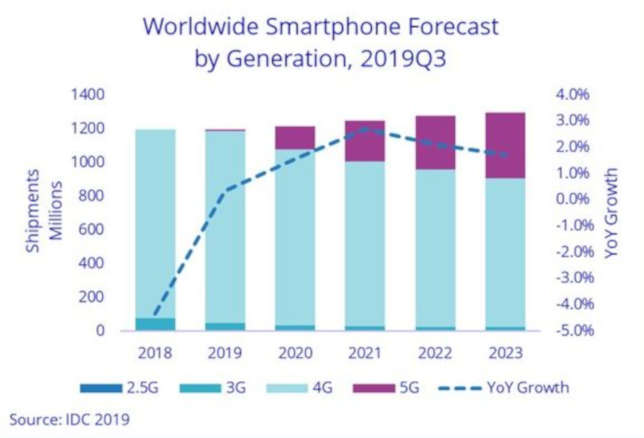5G to Drive Pickup for Smartphones in 2020
- By Dian Schaffhauser
- 12/10/19
Personal computing device (PCD) shipments are looking stronger than expected for 2019, and smartphone deliveries are expected to bump up in 2020, according to two separate analyses by International Data Corp.
According to IDC's Worldwide Quarterly Personal Computing Device Tracker, the outlook for PCDs is stronger than expected for the rest of the year, the IT analysis firm reported, driven in large part by organizations upgrading their hardware in response to Microsoft's end of support decree for Windows 7, occurring in January 2020. The PCD segment includes traditional desktops and notebooks, as well as newer form factors, such as 2-in-1s and "thin and light" notebooks.
At the same time, however, 2020 isn't expected to have quite as strong PCD demand, noted Research Manager Jitesh Ubrani, in a statement. The company is predicting a seven percent decline in shipments for the new year, driven by "upcoming tariffs combined with expected chip shortages."
Two areas where the outlook for desktops and notebooks will remain durable are in markets for "creator PCs" and gaming PCs.

Slate tablets are expected to continue their "downward trajectory" as customers hold onto them longer and as players in the market -- including Apple, Samsung and Huawei -- "slowly shift their product portfolio toward detachable tablets."
Another area to monitor: cellular-enabled PCs, which will see deals between telecommunications companies and mobile chip makers (Intel, Qualcomm and MediaTek among them) working to introduce 4G-enabled devices "in the short term" and 5G-enabled devices "in the long term."
Simultaneously, after three years of "contraction" for smartphone shipments worldwide, that segment of the device market is expected to grow in 2020, driven by "ambitious 5G plans," particularly in China, but also in the United States, Korea, the United Kingdom and Canada.
In its Worldwide Quarterly Mobile Phone Tracker, IDC predicted that the global smartphone market would grow 1.5 percent year over year in 2020, shipping just over 1.4 billion units, including some 190 million 5G smartphones -- about 14 percent of the total.
Even as some smartphones have crossed the thousand-dollar threshold, Android vendors will help drive down the cost for 5G models, "starting with an abundance of first quarter announcements" at both CES (in Las Vegas in January) and Mobile World Congress (in Barcelona in February). Android's hold on the market was expected to rise from 85.1 percent in 2018 to 86.6 percent in 2019.
However, 2019 has proven a challenging year for Apple, with the volume of shipments expected to drop by 11.4 percent this year over last year, "mostly due to stressed market headwinds as well as a lack of 5G devices," IDC reported. The company said that Apple was expected to make a 5G announcement in its annual September event, "with a real focus around pricing and market availability."
"Accelerated 5G adoption globally will depend a lot on factors like the arrival of 5G networks, operator support, as well as substantial price reductions to offer more affordable 5G devices," explained Sangeetika Srivastava, senior research analyst.
About the Author
Dian Schaffhauser is a former senior contributing editor for 1105 Media's education publications THE Journal, Campus Technology and Spaces4Learning.